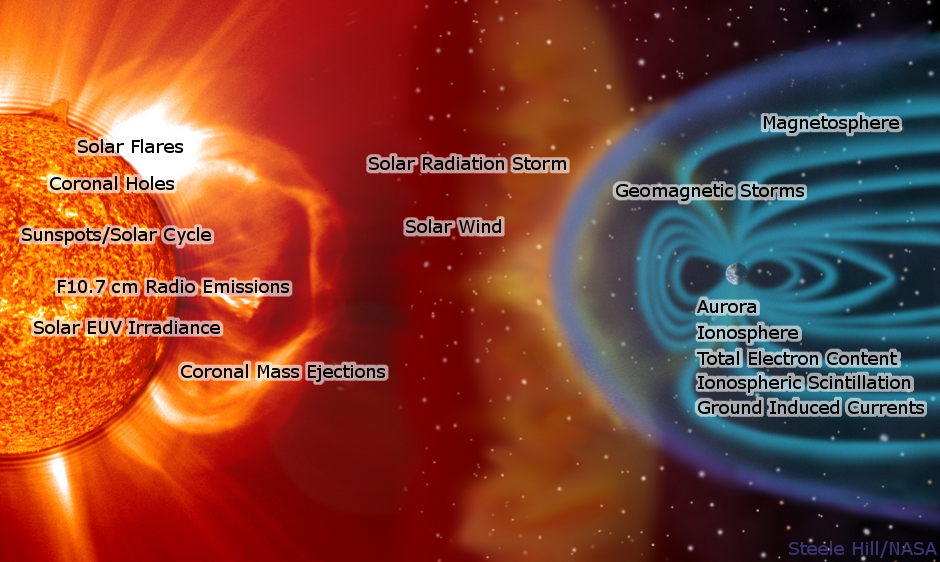SPACE WEATHER PHENOMENA

ABOUT SPACE WEATHER PHENOMENA
Space Weather describes the variations in the space environment between the sun and Earth. In particular Space Weather describes the phenomena that impact systems and technologies in orbit and on Earth. Space weather can occur anywhere from the surface of the sun to the surface of Earth. As a space weather storm leaves the sun, it passes through the corona and into the solar wind. When it reaches Earth, it energizes Earth’s magnetosphere and accelerates electrons and protons down to Earth’s magnetic field lines where they collide with the atmosphere and ionosphere, particularly at high latitudes. Each component of space weather impacts a different technology. A description of some of the space weather impacts can be found at Space Weather Impacts.
AURORA
The Aurora Borealis (Northern Lights) and Aurora Australis (Southern Lights) are the result of electrons colliding with the upper reaches of Earth’
CORONAL HOLES
Coronal holes appear as dark areas in the solar corona in extreme ultraviolet (EUV) and soft x-ray solar images.
CORONAL MASS EJECTIONS
Coronal Mass Ejections (CMEs) are large expulsions of plasma and magnetic field from the Sun’s corona.
EARTH'S MAGNETOSPHERE
The magnetosphere is the region of space surrounding Earth where the dominant magnetic field is the magnetic field of Earth, rather than the magnet
F10.7 CM RADIO EMISSIONS
The solar radio flux at 10.7 cm (2800 MHz) is an excellent indicator of solar activity.
GALACTIC COSMIC RAYS
Galactic Cosmic Rays (GCR) are the slowly varying, highly energetic background source of energetic particles that constantly bombard Earth.
GEOMAGNETIC STORMS
Geomagnetic storms are fluctuations in the Earth's magnetic field, caused by changes in the solar wind and interplanetary magnetic field.
IONOSPHERE
The Ionosphere, between 80 and ~600 km in the Earth’s upper atmosphere, is where solar radiation caused ionization creates a layer of electrons that can effect earth systems.
IONOSPHERIC SCINTILLATION
Ionospheric scintillation is the rapid modification of radio waves caused by small scale structures in the ionosphere.
RADIATION BELTS
Radiation belts are regions of enhanced populations of energetic electrons and protons surrounding the Earth in space.
SOLAR EUV IRRADIANCE
Solar Extreme Ultraviolet (EUV) is solar radiation that covers the wavelengths 10 – 120 nm of the electromagnetic spectrum.
SOLAR FLARES (RADIO BLACKOUTS)
Solar flares are large eruptions of electromagnetic radiation from the Sun lasting from minutes to hours.
SOLAR RADIATION STORM
Solar radiation storms occur when a large-scale magnetic eruption, often causing a
SOLAR WIND
The solar wind continuously flows outward from the Sun and consists mainly of protons and electrons in a state known as a plasma.
SUNSPOTS/SOLAR CYCLE
Sunspots are dark areas that become apparent at the Sun’s photosphere as a result of intense magnetic flux pushing up from further within the solar
TOTAL ELECTRON CONTENT
The Total Electron Content (TEC) is the total number of electrons present along a path between a radio transmitter and receiver.

















